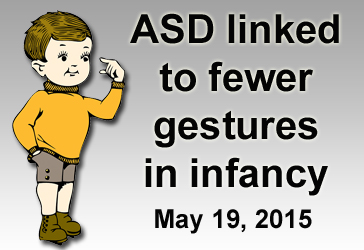Check out other stories from the Latest News
ASD Linked to Fewer Gestures in Infancy
By Chelsea E. Toledo, M.A. on May 19, 2015

Background: One of the trademark symptoms of Autism Spectrum Disorder (ASD) is impaired communication, which is accompanied by difficulty with social interaction and restrictive, repetitive behaviors. Although ASD is typically not diagnosed until later in childhood, language delay can present itself as early as the first year of life.
What’s New: The January 2015 issue of the Journal of Autism and Developmental Disorders included a study examining the relationship between language production and the gesture use by infants and their caretakers earlier in life. The researchers performed observational screenings on a total of 75 infants—48 who had a sibling with ASD and 27 who did not. During observation, the researchers evaluated maternal and infant gestures at 12 months of age and the children’s subsequent language production at 18 months of age.
The research team found that the infants who later fit the ASD profile produced the fewest gestures, and that the use of gestures by mothers only affected the language production of the infants who did not fit the ASD profile. They also observed that mothers of the infants deemed high-risk for ASD by virtue of having a sibling with the disorder tended to produce more gestures, such as pointing and nodding when interacting with their children.
Why it’s important: This study reinforces other research suggesting a delay in gesture production in infants who would ultimately receive an ASD diagnosis. Future research could illuminate intervention strategies based on interactive gesturing by caretakers.
Help me understand :
| Source(s) : |
| Tweet |

